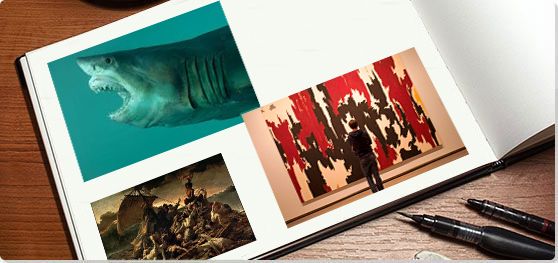Summary of The Sublime in Art
Feelings of terror, awe, infinity, and minuteness swirl and course through an experience of the sublime in nature, and for centuries, artists from Donatello to Bill Viola have attempted to recreate that experience in their paintings, sculptures, and video projections. Theorized as early as the 1st century, the sublime has captivated writers, philosophers, and artists alike. Through its various definitions and interpretations, at its base, the sublime is a feeling rooted in humans' relationships to the world, to nature, and what lies beyond that help us to formulate an understanding of ourselves.
Because the experience of the sublime is relational - we feel ourselves in relation to something larger than ourselves - artists interested in the sublime use myriad methods and mediums - from color and perspective to immersive installations and sound - to create an experience that engages the viewer's senses and brings him or her into the work. Artists employ the sublime to comment not only on our relationship with nature, but the fast-changing pace of technology as well as troubling contemporary events of war and violence.
Key Ideas & Accomplishments
- Modern evocations of the sublime took root in the philosophical writings of the 17th and 18th centuries. In order to understand human feeling and passions, writers attempted to systematically interrogate the sources of said feelings. Most influentially, Emmanuel Kant located the sublime in humans' incapacity to understand terrifying vastness and because of this we recognize our own smallness and limitations.
- So often the sublime evokes a sense of what is beyond us that we cannot comprehend, and for this reason it has long been associated with religion, spirituality, and transcendence. Even in secular contexts, the sublime conjures something awe-inspiring and reminds us that humans are not necessarily at the center of the world.
- In the 20th century, artists interested in the sublime often turned to machines, technology, and factories to find the extraordinary and overwhelming. Human technology now captures the imagination and controls much of our life, and what began as an enthusiastic embrace of how technology can enrich our world has in many cases turned into a fear of the technological sublime.
- The politicization and commodification of sublime spectacle has led recent scholarship to look more closely at the sublime and its relation to capitalism and how experiences of nature and technology are sold to consumers. Whether with eco-tourism or an exhibition spectacle at a museum, people increasingly pay for a sublime experience, and some would argue that the contamination of the experience by capital subverts the original ideas of the sublime.
The Important Artists and Works of The Sublime in Art

The Raft of the Medusa
Many consider this gory and chilling work to be Géricault's magnum opus, and it changed the direction of modern art. The enormous canvas, almost 23 by 16 feet, depicts the survivors and less fortunate occupants of a life raft that had been cut adrift from a stricken French navy frigate, sunk by an incompetent captain. Dead or dying, the figures cut a horrifying scene as they are thrown about on the turbulent West African sea. When the raft was eventually rescued after 13 days, only fifteen men remained alive. Another five died during the voyage, and the event caused a contemporary scandal surrounding France's colonial aspirations.
As history painters had never before depicted a contemporaneous event, the work shocked the public, and its gruesome rendering further outraged them. Géricault went to great lengths to portray realistically the horror of the event, visiting morgues to study the skin color of the dead, even taking body parts home to work from as models. The pyramidal structure, comprising the raft's corners and the rickety mast, add to the drama of the gruesome scene. He also uses chiaroscuro to add drama to a terrifying sky and to highlight the deathly pallor of the parched bodies. By allowing the edges of the raft to move beyond the bottom of the frame, the artist invites the spectator onto its perilous floor, and by turning the stricken subjects' heads and arms towards the horizon, the viewer is drawn more deeply into the terrible scene as they hopelessly seek rescue.
The notion of horror and death is a key motif in the exploration of the sublime. Edmund Burke wrote, "Whatever is fitted in any sort to excite the ideas of pain, and danger, that is to say whatever is in any sort terrible...is a source of the sublime; that is, it is productive of the strongest emotion which the mind is capable of feeling." Géricault's fascination with the macabre can also be seen in Francisco Goya's powerful plates, The Disasters of War produced ten years previously. And artist have sought to replicate a morbid fascination up until today as artists including Joseph Beuys, Anselm Keifer, Doris Salcedo, and Damien Hirst explore the sublime in reaction to traumatic events and death.
Oil on canvas - Musée du Louvre, Paris

Salisbury Cathedral from the Meadows
In Salisbury Cathedral from the Meadows the sublime becomes apparent in the work's moody skies and teeming symbolism. An influential figure in the Romantic movement, Constable became known for his unique treatment of light and use of vibrant, naturalistic colors, but this large canvas has a dark and ominous feel and raises questions about the future of the Anglican Church. In the center of the scene, the spire of Salisbury Cathedral pierces the lightening-cleaved clouds, but the contrasting lights in the scene solicit a symbolic reading of the church. Divided diagonally across the center, the left bottom triangle shows in muted browns and oranges a pastoral scene, and a man on horse and cart wade through a stream. A large tree on the left casts a deep shadow over the scene. Despite the presence of a rainbow cutting through the upper triangle of the composition, the sky is dark and brooding. Shafts of light battle with squalls of rain, and the reds of the gray sky are used to threatening effect. Many have also tied the contrasting moods to Constable's own psychological state after the death of his wife.
Art historian Anne Lyles says the work represents the "transcendental sublime," explaining, "When the painting was exhibited at the Royal Academy in 1831, the critics acknowledged the extent to which it differed from the artist's previous work, but struggled to define the ways in which this was so. Their descriptions ranged from 'exaggerated,' 'theatrical,' and 'unnatural.'" But Charles Robert Leslie, Constable's biographer, wrote that the artist believed the work conveyed "the full impression of the compass of his art" and that one day it would probably "be considered his greatest" picture.
Oil on canvas - Collection of the Tate, United Kingdom

Slave Ship (Slaves Throwing Overboard the Dead and Dying, Typhoon Coming On)
J.M.W Turner explored notions of impermanence, death, and violence in his seascapes and nature paintings. In this dynamic and expressive work, Turner uses a palette of fiery reds and yellows to depict a treacherous ocean. The bottom half of the canvas depicts a tumultuous sea, in which animals and slaves are engulfed. Flame-like waves lick at the fiery sky as a spindly, vulnerable ship sails away, abandoning the overthrown. The horizon seems to pivot, emphasizing the fear and chaos experienced by the drowning. Here, a number of sublime concepts are at play: the sun, godlike but uncaring, in the center of the canvas evokes the spiritual, the menace of drowning and death loom, and nature is presented as all-powerful and terrifying.
The work was based on a poem about the true story of slave ship whose captain had thrown sick and dying slaves overboard so he could claim insurance on lives lost at sea. Turner was fascinated by the human and elemental violence, and the sea provided a powerful place for an exploration of the sublime. Writer Alison Smith said, "Turner's works have been seen to both elevate and inspire perception in the beholder." Turner used skilled brushwork and color effect to unsettle the viewer. The critic John Ruskin wrote, "If I were reduced to rest Turner's immortality upon any single work, I should choose this."
Oil on canvas - Museum of Fine Arts Boston, USA

The Chasm of the Colorado
In this bright and dramatic work, the canvas' middle opens up to an enormous gulf, into which are sucked the sky and the clouds. The red structure of the Grand Canyon surrounds the chasm, towering up the left of the canvas. The power of the scene is emphasized with bold reds and blacks, while the distant horizon, rendered in soft blues, oranges, and yellows, extend the reach of the enormous landscape. Dark rainclouds pour into the ground, while water bubbles up from the earth in a steamy mist. The work is almost biblical in its celebration of majesty and power. The embellishment of a rainbow completes the picture and references the great end-of-days flood of the Old Testament.
From his vantage point at Powell's Plateau - a northwestern Grand Canyon summit - Moran at once produced an image that points to a still, unmoving, and uncaring history of the earth, while also introducing dynamism through the active weather-scape. This dichotomy conveys a sense of irrelevancy in the viewer who looks on at the entirely unpeopled scene. Moran worked with explorer and geologist John Wesley Powell as he painted the composite, using sketches, photographs, and compositions rather than a direct observation of the view. Powell wrote, "Mr. Moran has represented the depths and magnitudes and distances and forms and color and clouds with the greatest fidelity. But his picture not only tells the truth...It displays the beauty of the truth."
Oil on canvas - Smithsonian American Art Museum, Washington DC

Black Square
This work comprises a black square set slightly askew on a white field. This small and seemingly simple canvas turned the art world on its head. Originally conceived as a set design for the last scene in an avant-garde opera, Black Square epitomizes the style Malevich named Suprematism, a form of pure abstraction which was totally non-figurative and non-descriptive. In producing a work with no color, no form, no symbolism and no message, Malevich claimed to have "freed art from the burden of the object." He thought that perception should be freed from logic and reason and that absolute truth could only be realized via feeling.
Art critic Will Gompertz explained that Malevich deliberately induced a state of confusion in the viewer as she sought to find meaning. "Once it had escaped from its rationalist prison, the unconscious mind would be able to 'see' that the artist was presenting the entire cosmos, and all life within it, in his small, square, simple painting." Gompertz, here, describes the transcendental sublime; the work takes the viewer beyond the defined, rational limits of understanding. Further, as scholar Philip Shaw explains, "Favoring flatness over depth, Black Square conveys, in the words of Kant's Analytic of the Sublime (1790), 'the feeling of displeasure that arises from the imagination's inadequacy.'" In our incapacity to find a rational meaning for Black Square and in the unease one feels in that situation, Malevich succeeded in conveying the sublime through completely abstract means, an accomplishment that would propel subsequent artists, including Americans Ad Reinhardt and Mark Rothko, to advance their own versions of it.
Oil on canvas - State Tretyakov Gallery, Moscow

Vir Heroicus Sublimis
This vast Abstract Expressionist painting consists of a deep, saturated, matte red. Across the almost 18 by 8 foot canvas five vertical bands, called "zips" by Newman, punctuate the field of red. Working from the left, we see a slightly brushy orange zip, followed by a thicker, bright white zip. On the right, a dark maroon zip divides the work again, and another orange zip is painted to its right. A year later, Newman added the final zip; a thick, tan line that hugs the edge of the canvas.
At the time, it was Newman's largest painting, and it was supposed to redraw the lines between artist and the viewer, who was encouraged to examine the canvas up close. When standing at the proper distance, the colors and lines morph and envelop the viewer, and the light of the red canvas is cast back upon them, changing their own appearance - the work alters the viewer visibly and hopefully, per Newman's intentions, metaphysically.
The title of the work, translated from Latin means "Man, heroic and sublime." In his 1948 essay, "The Sublime is Now," Newman argued that Europe had failed to find the sublime in modern art, but that in America, freed from the weight of European culture, artists could realize the sublime. He wrote, "We are freeing ourselves of the impediments of memory, association, nostalgia, legend, myth...that have been the devises of Western European painting. Instead of making cathedrals out of Christ, man or 'life,' we are making them out of ourselves, out of our own feelings." In eschewing the figure and landscapes, Newman and his colleagues made their subject human existence and experience. As philosopher Paul Crowther writes, "The implied analogy is that just as the zip is properly defined and comprehensible only through its opposition to the color-field, so humanity can only define and express its own finite rational nature in opposition to the infinite and unknown." The relationships that Newman created between the vertical lines and the horizontal red field, then, stand in for, or evoke, our relationship with the world, with nature.
Oil on canvas - The Museum of Modern Art, New York

The Physical Impossibility of Death in the Mind of Someone Living
This huge tank, containing a 14-foot-long dead tiger shark suspended in blue formaldehyde solution, shocked and unsettled the public when it was first unveiled in 1991. The work launched Hirst's career; he said he wanted "to make a sculpture where the fragility was encased...[and] exists in its own space." The shark has long been an emblem of the sublime; a graceful, powerful creature, inextricably related to violence and death, reminiscent of the ocean and drowning in the great abyss. Hirst described the shark as the "universal trigger," capable of instilling fear in all.
Art historian Luke White suggests that while Hirst's work echoes Burke's fascination with the body, mortality, violence, pain, and power, Hirst's very being and cultural capital make him symptomatic of the contemporary sublime and its entanglement with commercial concerns. White explains, "Hirst's restaging of the Burkean sublime places him in a long tradition of the commercial exploitation of the tropes and themes of the sublime." Art critic Jonathan Jones is a bit less critical of Hirst's commercialism, as he describes the work as "genuinely profound." He writes, "There it was: life, or was it death, relentlessly approaching me through deep waters. It was galvanizing, energizing. It was a great work of art." But just as the piece invites a meditation on the relentless march or life into death, the work itself is impermanent. The shark began to disintegrate and was replaced in 2006. Nothing lasts forever.
Glass, painted steel, silicone, monofilament, shark and formaldehyde solution - Here installed in the Saatchi Gallery, London
Nantes Triptych
Bill Viola uses experimental sound and video to create an experience. The Nantes Triptych references religious art in its name and in its format of three panels of video. On the far left, a woman is giving birth and the footage catches the moment when the baby is first placed into the mother's arms. In the middle, a fully-clothed man floats in a black watery void. On the right is footage from the end of the artist's own mother's life as she lies still, taking her last breaths on her death bed. Against these powerful scenes, clashing sounds are played: crying, breathing, and water sounds.
Viola explained that he wanted to "go to the future with sound and electronics" to project the great universal experiences, which are at once deeply personal and private but at the same time common to all. Viola explained that the presence of the camera in each of these private scenes is "the embodiment of invasion of privacy" and adds to the work's tension. While the technological sublime attempts to make sense of age-old experiences, beliefs, and mysteries using the most up-to-date science, Viola wanted to explore how art takes place within a continuum and that in this way he is no different to his Renaissance forebears. He said, "Renaissance artists were exploring the same thing. The renaissance was a meeting of science and art. Perspective would have seemed like computer CGI graphics now."
Viola, a student of Zen meditation, uses Eastern philosophy to inform his artistic investigation into the relationship between an individual's inner life and bodily experience. He said, "The word 'sublime' means being overwhelmed, not just physically, the way a great storm at sea would, but being overwhelmed emotionally, spiritually, within every fiber of your body. Not destruction or chaos, but absolute revelation and truth of the moment. Absolute confirmation that this moment is an eternal moment."
Video, 3 projections, color and sound (stereo) - Collection of the Tate, United Kingdom

Descension
In this sculptural work, which has been exhibited at the Château de Versailles in France, the Galleria Continua in Italy, and New York's Brooklyn Bridge Park, we see a huge, circular void in the ground filled with water. Within that, a vortex swirls continually, sucking the water down into its depths. It is unclear how deep the body of water is, and in some incarnations the interior of the pool is black, taking away any hint of what is within, while also giving the impression that the water is icy cold. The water spirals constantly, and within that movement the vortex itself moves gently in its own orbit as white bubbles make their own shapes that spin out to the work's edges. When the work was exhibited in France and Italy, there were no ropes around it; the viewer could have easily stepped or fallen in, and sensing the danger, some spectators stepped warily back from it while they peered down, as if standing at a cliff edge.
Bombay-born British artist Anish Kapoor's work aims to provide a narrative without storytelling. "I seem to be making sculpture about the space beyond illusory space," he explained. Creating large sculptures that dominate the viewer, his use of outdoor space, and mirrored-glass structures that reflect the sky, Kapoor's works bring nature back to us, urging us to reconsider our relationship with the natural world.
Kapoor's conceptual work Descension speaks to a postmodern age in which our own security within nature is a given. We no longer need fear sharks and shipwrecks, but that does not mean we're ever really safe. In returning to the water motif, the work is designed to make the viewer feel uncomfortable. Its use as a medium invites self-reflection, and more darkly, invites our primordial brain to contemplate peril and death; blackness, depth, and the infinite. It makes us think of our own impermanence. In 1990, Kapoor talked about "void states" as an internal experience linked to fear. "There is nothing so black as the black within," he said.
Brooklyn Bridge Park, New York
Beginnings
Boileau and Longinus - On the Sublime (1674)
The concept of the sublime can be traced as far back as the Italian Renaissance. Masaccio and Andrea Mantegna's representations of Christ dead and dying, as well as Raphael's drawings and studies of skulls, remind us of the inevitability of death and the unknown - key themes of the sublime. Painter and theorist Jonathan Richardson wrote extensively about the sublime and its example in Michelangelo and the Baroque painter Anthony van Dyck in his An Essay on the Theory of Painting (1715).
But it was not until the Romantic period that the sublime as an aesthetic concept really took hold across Europe. It began with the French author Nicolas Boileau-Despréaux's 17th-century translation of Peri Hypsous (On The Sublime), a work of literary criticism by the Greek Longinus dating back to the 1st century CE. Here, Longinus argues that the orator should strive to inspire passion and move his listener not just to persuade him. Concerned mostly with language, Longinus does write briefly about the visual sublime in both nature and human-made objects; great size and variety can induce the feeling of the sublime in his estimation. In his own treatise on aesthetics, Boileau wrote of the sublime, "The sublime is not strictly speaking something which is proven or demonstrated, but a marvel, which seizes one, strikes one, and makes one feel."
The Romantic Sublime and Edmund Burke

In 1757, the philosopher Edmund Burke wrote the first major work on the sublime, in which he sought to scientifically investigate human passions. As a philosophical Empiricist, Burke grounded his argument in sensory experience, and he walks through various feelings, including the pleasurable, the beautiful, and the sublime. For Burke, pleasure was not as strong a feeling as pain, and he proposed that the sublime, which he understood to be our strongest passion, was rooted in fear, particularly the terror brought on by the fear of death. Burke wrote, "The passion caused by the great and sublime in nature, when those causes operate most powerfully is astonishment, and astonishment is that state of the soul in which all its motions are suspended, with some degree of horror."
Kant's Critique of Judgment (1790)
Similarly, German philosopher Immanuel Kant explored the individual's response to the sublime, placing the origin of the experience within the human psyche. In his Critique of Judgment. Kant proposed two types of sublimity: the mathematical and the dynamical. With the mathematical sublime, one is faced with the magnitude of nature, and one's imagination cannot adequately comprehend the vastness. Kant argues, though, that our faculty of reason kicks in and allows us to comprehend the sense of infinity before us; the feeling of the mathematical sublime, then, is the feeling of reason's superiority over nature and our imagination. The dynamical sublime is also a feeling of reason's superiority to nature, but via a different avenue. Kant explained, "[T]he irresistibility of [nature's] power certainly makes us, considered as natural beings, recognize our physical powerlessness, but at the same time it reveals a capacity for judging ourselves as independent of nature and a superiority over nature...whereby the humanity in our person remains undemeaned even though the human being must submit to that dominion." In both experiences of the sublime, Kant wrote of an "agitation" that one feels; it makes the soul feel shaken, as opposed to the calm feeling engendered by a work of beauty. The sublime also causes a feeling of displeasure, as Kant explained, "arising from the inadequacy of imagination in the aesthetic estimation of magnitude to attain to its estimation of reason...." Kant's notions of the sublime were not much taken up by philosophers, but they held great importance for later literature and aesthetic theory.
The European Romantics

According to art historian Beat Wyss, Kant's sublime, which rests on our relation with nature and our rational response to it, was translated into German Romanticism as a form of "art religion." Here, was the dawn of an era in which "the ego and the world diverged". Romantic artists would often use their experiences of nature or natural events to convey the experience of the sublime. Kant's countryman, Caspar David Friedrich's paintings of mist, fog, and darkness sought to capture an experience of the infinite, creating an overwhelming sense of emptiness. Friedrich's images of lone figures against powerful and dramatic skies had a wide-reaching influence and made him an icon of Romantic Painting. In France around the same time, Eugène Delacroix and Théodore Géricault explored the sublime through violent and horrific subjects such as suicide, massacres, shipwrecks, and guillotined heads. Their paintings were often massive in scale, enveloped the viewer, and the frequent presence of a cacophony of varied details overwhelmed the viewer's senses.
British Landscape Painting and French Barbizon School

As travelers headed into wilderness such as the French and Swiss Alps, the Snowdonia mountains, and other natural regions to experience the sublime, British Landscape painters responded to the desire for thrill and awe. John Constable presented dramatic English landscapes that were designed to evoke awe and wonder in the viewer while his contemporary and rival J. M. W. Turner produced powerful seascapes, views of the Thames river, and captivating skies that explored the ephemerality of man's efforts in the face of nature. Indeed Turner has been widely recognized as one of the most successful of Romantic painters in capturing the aesthetic of the sublime as outlined by Burke and Kant.
In France, a more middle-of-the-road approach was explored by the Barbizon School, which included Jean-Baptiste-Camille Corot, Théodore Rousseau, and Jean-François Millet. These painters sought to convey a sense of serenity, or what was termed the "contemplative sublime," in landscape painting. Here artists turned to nature painting as an antidote to the ills of modern industrialization, rather than as a powerful investigation into the human condition.
The Hudson River School

Inspired by Turner and his contemporaries, artists such as Thomas Moran and Thomas Cole found the sublime in the untouched lands of North America, including in the Yosemite Valley, the Grand Canyon, the Rocky Mountains, and reflected it on vast canvases that expressed scale and splendor. Artists wanted to produce work that translated the awe, terror, boundlessness, and divinity experienced at these dramatic spots that many Americans had not seen in person. Many of the artists who came to be known as the Hudson River School (named after the houses many of them built on the river in upstate New York) worked in the Studio Building on New York's West Tenth Street, the first such artists' space of the time in the city. After traveling the country and the countryside and experiencing the richness of the American landscape, Albert Bierstadt and Frederic Edwin Church, and later Asher B. Durand, explored notions of the sublime at a time during westward expansion, and their painted visions came to define what America looked like in the minds of many of its East Coast citizenry.
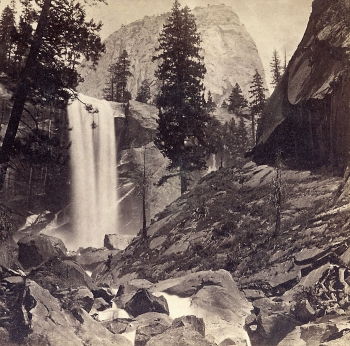
In the 1870s and 1890s, pioneering photographers were employed by the government and private companies to capture images of the Western landscape, including Yosemite and Yellowstone. The photographs taken of Yosemite by Carleton Watkins influenced the U.S. Congress to make it a national park. Later photographers such as Minor White and Ansel Adams continued the legacy of dramatic landscape photography that captured the imaginations of Americans.
The Death of the Sublime
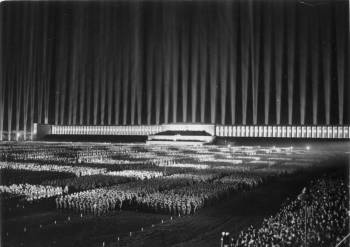
By 1886 the philosopher Friedrich Nietzsche declared the Sublime "out of date" and Victorian artists returned to beauty as their muse. By the turn of the century, the United States had moved on too, falling in love instead with French Impressionism and modernism. Adding to its demise as an influential aesthetic theory, notions of the sublime were exploited by totalitarian regimes in the 1930s. Caspar David Friedrich's work was co-opted by the Nazis and twisted into an exemplar of German nationalism. Hitler's chief architect Albert Speer created Cathedrals of Light. In the absence of a concrete stadium, Speer beamed 152 anti-aircraft searchlights into the night sky to form a wall of vertical lights around the audiences of the Nuremberg rallies. The effect was dazzling and footage was subsequently documented in Nazi propaganda films. The overtly political use of the sublime made subsequent artists reluctant to engage the aesthetic theory in their works.
The Age of Abstract Expressionism
After World War II, artists again began to explore sublime feelings of transcendence and exaltation as a way to recuperate from the war's atrocities. The Abstract Expressionists in North America and Europe's innovative Yves Klein, the sculpture of Alberto Giacometti, and the poems and paintings of Henri Michaux all re-engaged the topic.
In his 1948 essay "The Sublime is Now," Barnett Newman swore off the European artists' interest in beauty and argued that artists needed to create transcendent works that would induce a spiritual experience. He wrote, "We are reasserting man's natural desire for the exalted." Fellow artists Mark Rothko and Clyfford Still also wanted to evoke a quasi-religious transcendent experience in those viewing their works.
The eminent art historian Robert Rosenblum caused a stir when he coined the term the "abstract sublime" in reference to modern American painting. He used it to describe a sense of vastness and solitude conveyed by works of Abstract Expressionists, relating them back to their ancestors in Romantic painting. He developed the ideas in his influential book Modern Painting and the Northern Romantic Tradition: Friedrich to Rothko (1975). Writing in 1961, Rosenblum said, "In its heroic search for a private myth to embody the sublime power of the supernatural, the art of Still, Rothko, Pollock and Newman should remind us once more that the disturbing heritage of the Romantics has not yet been exhausted."
Concepts and Styles
Religion and Transcendence
The sublime and the religious have been linked as far back Roman times, and writers praised Renaissance artists that moved the viewer beyond an everyday appreciation of religious works. Jonathan Richardson described Raphael's Sistine Chapel tapestries as the most sublime examples of art, while he also paid tribute to the "holy Dove with a vast Heaven where are innumerable angels adoring, rejoicing" in Federico Zuccaro's The Annunciation with Prophets and Music-making Angels (1572). The vastness and terror of nature explored by Romantic painters often had religious undertones - for example, Caspar David Friedrich painted monks and funereal scenes and was greatly influenced in his thinking by a Lutheran minister.
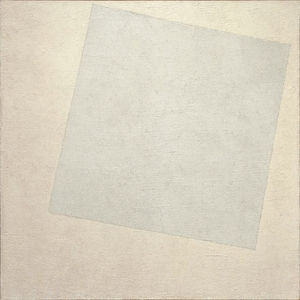
Early 20th-century art took the sublime in a new direction, as artists experimented with abstraction to provide an experience of transcendence. Kazimir Malevich famously hung his Black Square (1913) in the corner of the room when it was first displayed. As this was traditionally the site of the orthodox icon in a Russian home, Malevich suggested the black square as a godlike presence. Although kept hidden away for many years, the Swedish Hilma af Klint produced a huge body of abstract work, known as The Paintings for the Temple, which she hoped would provide an experience of enlightenment for those who viewed them.
Later, Abstract Expressionists would try to evoke a spiritual feeling through their work. Robert Rosenblum, writing in 1961, described a fan admiring Clyfford Still works at New York's Albright Art Gallery. "It's like a religious experience!" he told Rosenblum. Likewise, Mark Rothko and Barnett Newman's Color Field Paintings attempted to create a quasi-religious feeling for a post-religious world.
Nature

Nature was a key motif for the sublime in Romantic art; misty skies, tempestuous seas, vast gulfs and valleys, and dramatic mountain scenes were depicted on large-scale canvases to take the viewer's breath away. The natural world, for Burke, was the most sublime of objects, and James Ward's Gordale Scar (1812-14) attempts to translate the sublimity of nature by presenting a dramatic view of limestone rocks cutting through the majestic landscape of Yorkshire (in Great Britain) set against a dark and ominous sky.
The burgeoning popularity of the sublime in nature inspired Thomas Moran, who travelled across the Atlantic Ocean and shared what he had learned with his American contemporaries in the Hudson River School where depth, space, and drama became the order of the day. In France, the painters of the Barbizon School Jules Dupré (inspired by Constable) and Theodore Rousseau used nature to explore themes such as the insignificance of humanity and the transience of life, which went on to inform Impressionism.
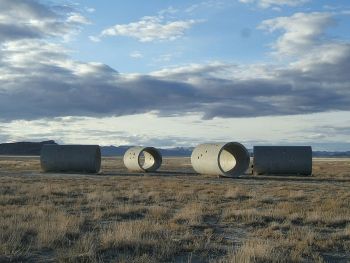
The theme manifested itself in the 21st century as nature morphed from the subject to the medium, and the American West - previously depicted as a dangerous frontier - became the site of Earth Art. Michael Heizer's Double Negative (1969) evokes feelings of awe and dread as two vast trenches measuring 1,500 feet long, 50 feet deep, and 30 feet wide (so large they can be seen as dark shadows in Google Map's satellite imagery) are cut into the earth dwarfing the viewer. Likewise, Nancy Holt's Sun Tunnels (1973-76), in the Utah desert aim to connect the viewer with the cosmos, highlighting human insignificance while simultaneously and paradoxically elevating them. The work comprises four concrete tunnels, drilled with holes to pattern the constellations of Draco, Perseus, Columbia, and Capricorn in a bid to bring the sky to earth. Holt said she wanted to examine "the human perception of time and space, earth and sky".
Terror and Death
Sublime art is meant to shake the viewer, to instill fear, and remind them of their own fragile mortality. Burke wrote about a "terrible sublimity" linked to notions of death, powerlessness, and annihilation and in doing so, like Longinus, likened it to the vast, uncontrollable, unknowable ocean. Artists such as Turner and Claude Joseph Vernet translated this in their depictions of shipwrecks, which pose not just fear of death but the fear of the unknown presented by drowning.
Burke linked pain with death, explaining, "what generally makes pain itself, if I may say so, more painful, is that it is considered as an emissary of this king of terrors." Such terror is seen in Eugène Delacroix and Théodore Géricault's gory and visceral works. That tradition manifested itself throughout the 20th century as well, in the works of Paul Cezanne's The Three Skulls (1900), Pablo Picasso's Guernica (1937) and Frida Kahlo's Girl with Death Mask (1938).
Contemporary artists have explored the terrible sublime in explorations of recent political events and their effects on our individual and collective psyche, while art critic Thomas McEvilley predicted at the turn of the century that "the culminating developments of capitalist globalization would be the terror-sublime of the next 50 years".
Technology and Modernity

At the turn of the century, artists began looking at the way changes in industry affected the human experience. New York's waterways became a subject for the Ashcan School and artists such as George Bellows, Robert Henri, Reginald Marsh, and Georgia O'Keeffe painted bridges, cranes and ocean liners. In Europe, the technological sublime was explored by the Italian Futurists, such as Filippo Tommaso Marinetti and Umberto Boccioni, who used science and mechanics to unsettle the viewer and reject tradition and the past. More recently, cultural historian David Nye, in American Technological Sublime (1994) proposed that the admiration of the natural sublime, as experienced in dramatic landscapes, was replaced by the sublime of the factory, aviation, war machinery, and the sublime of the computer.
More recently, artist Simon Morley has situated the contemporary sublime within the experience of modern life and its relation to science and technology as it hurtles into the unknown. He connects awe and wonder with terror, writing, "The sublime experience is fundamentally transformative, about the relationship between disorder and order, and the disruptions of the stable coordinates of time and space. Something rushes in and we are profoundly altered." In this context, artists including Anish Kapoor, Damien Hirst, Bill Viola, and Hiroshi Sugimoto examine the self and the role of the artist within the dizzying context of mass media and vertiginous technological advance.
Postmodernism and Conceptual Art
Conceptual artists have played with the notion of fear in a contemporary examination of the sublime. Anish Kapoor's Marsyas (2002) comprised vast sculptures that took up the entire Turbine Room at the Tate Modern, towering over viewers in a way that as the curators explain "permeate physical and psychological space." The structures were made of PVC to look like human skin and threatened to swallow up the viewer, like giant mouths.
Environmental artists such as Betty Beaumont and Agnes Denes meanwhile use the outdoor space to highlight the damage we are doing to the earth, and therefore not just the death of the individual but the death of humankind as a whole, and Andreas Gursky's photographs meanwhile look to Kant's mathematical sublime, as he presents complex and dizzying images that dwarf and confuse the viewer with repeated perspectives.

The sublime has always been used as a vehicle to make sense of (or communicate a failure to grasp) world events, and this is no different in a contemporary context. Julie Mehretu refers to the September 11 attacks in her abstract canvas Dispersion (2002). As artist Julian Bell explains, "Her melodramas of swooping vectors and nested graphemes, with their bravura, baroque complexity, seem to picture the dynamics of the age on a very large and general scale." And Luc Tuymans's Still Life of the same year was presented in reaction to the attacks on the US. The work depicted a fruit bowl on a vast canvas, representing an absolute nothingness and a monument to this inadequacy of language. As Simon Morley suggested, "In response to unimaginable horror, Luc Tuymans offers the sublime. A gaping magnitude of impotency, which neither words nor paintings could ever express."
Further Developments
In the 1980s, French philosopher Jean-François Lyotard ushered in a new wave of postmodern sublimity, exploring notions of pleasure and pain, neurosis and masochism. Lyotard's two influential essays "Presenting the Unpresentable: The Sublime" (1982) and "The Sublime and the Avant-garde" (1984) reignited the subject in public discussion and saw exhibitions that brought the debate back to the viewing public.
Lyotard looked back to Burke and into the present day, focusing on the dominance of temporality in artistic debate; he reframed Barnett Newman's phrase "The Sublime is Now," suggesting that "now" is, in fact, a moment of nothingness. He wrote, "The avant-garde task is to undo spiritual assumptions regarding time. The sense of the sublime is the name of the dismantling." Current thinking has also explored the notion of temporality in the sublime and asks how art can stretch or destabilize it. Icelandic-Danish artist Olafur Eliasson talks about the subjectivity of time and the "length of now."
Notions of fear and wonder have proven to be as irresistible to contemporary artists as they were to the Romantics. In 2018, the Chaos and Awe: Painting for the 21st Century exhibition at Tennessee's Frist Gallery presented works from artists grappling with the destabilizing effects of such 21st-century forces as globalism, mass migration, radical ideologies, and complex technologies. Curator Mark Scala said, "Many people today are feeling anxiety and helplessness. People are struggling to adapt to a period of instability and dramatic shifts in meaning." Through the works of Franz Ackermann, Wangechi Mutu, Ellen Gallagher, and Matthew Ritchie, Scala explored the precariousness of the contemporary world and how people respond to it.
Useful Resources on The Sublime in Art
- An essay on the theory of paintingBy Jonathan Richardson (1665-1745)
- Letters on Landscape, Paintings (1855): Asher B. DurandBy Asher B Durand (1855)
- Modern Painting and the Northern Romantic Tradition: Friedrich to RothkoOur PickBy Robert Rosenblum (May 23, 1977)
- Reading American ArtBy Marianne Doezema and Elizabeth Milroy (June 16, 1998)
- The SublimeOur PickEdited by Simon Morley (March 5, 2010)
 Ask The Art Story AI
Ask The Art Story AI